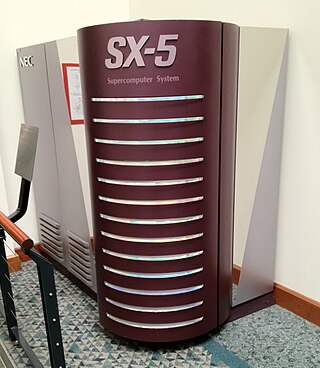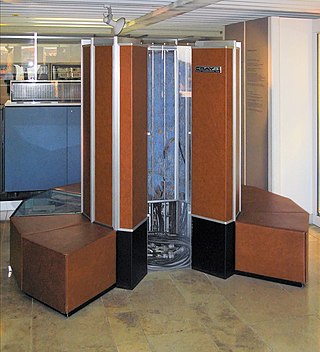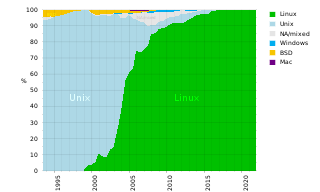Related Research Articles

Seymour Roger Cray was an American electrical engineer and supercomputer architect who designed a series of computers that were the fastest in the world for decades, and founded Cray Research which built many of these machines. Called "the father of supercomputing", Cray has been credited with creating the supercomputer industry. Joel S. Birnbaum, then chief technology officer of Hewlett-Packard, said of him: "It seems impossible to exaggerate the effect he had on the industry; many of the things that high performance computers now do routinely were at the farthest edge of credibility when Seymour envisioned them." Larry Smarr, then director of the National Center for Supercomputing Applications at the University of Illinois said that Cray is "the Thomas Edison of the supercomputing industry."

A supercomputer is a computer with a high level of performance as compared to a general-purpose computer. The performance of a supercomputer is commonly measured in floating-point operations per second (FLOPS) instead of million instructions per second (MIPS). Since 2017, supercomputers have existed which can perform over 1017 FLOPS (a hundred quadrillion FLOPS, 100 petaFLOPS or 100 PFLOPS). For comparison, a desktop computer has performance in the range of hundreds of gigaFLOPS (1011) to tens of teraFLOPS (1013). Since November 2017, all of the world's fastest 500 supercomputers run on Linux-based operating systems. Additional research is being conducted in the United States, the European Union, Taiwan, Japan, and China to build faster, more powerful and technologically superior exascale supercomputers.

The Cray-1 was a supercomputer designed, manufactured and marketed by Cray Research. Announced in 1975, the first Cray-1 system was installed at Los Alamos National Laboratory in 1976. Eventually, eighty Cray-1s were sold, making it one of the most successful supercomputers in history. It is perhaps best known for its unique shape, a relatively small C-shaped cabinet with a ring of benches around the outside covering the power supplies and the cooling system.
Control Data Corporation (CDC) was a mainframe and supercomputer firm. CDC was one of the nine major United States computer companies through most of the 1960s; the others were IBM, Burroughs Corporation, DEC, NCR, General Electric, Honeywell, RCA, and UNIVAC. CDC was well-known and highly regarded throughout the industry at the time. For most of the 1960s, Seymour Cray worked at CDC and developed a series of machines that were the fastest computers in the world by far, until Cray left the company to found Cray Research (CRI) in the 1970s. After several years of losses in the early 1980s, in 1988 CDC started to leave the computer manufacturing business and sell the related parts of the company, a process that was completed in 1992 with the creation of Control Data Systems, Inc. The remaining businesses of CDC currently operate as Ceridian.
In computing, a vector processor or array processor is a central processing unit (CPU) that implements an instruction set where its instructions are designed to operate efficiently and effectively on large one-dimensional arrays of data called vectors. This is in contrast to scalar processors, whose instructions operate on single data items only, and in contrast to some of those same scalar processors having additional single instruction, multiple data (SIMD) or SWAR Arithmetic Units. Vector processors can greatly improve performance on certain workloads, notably numerical simulation and similar tasks. Vector processing techniques also operate in video-game console hardware and in graphics accelerators.
In computing, floating point operations per second is a measure of computer performance, useful in fields of scientific computations that require floating-point calculations. For such cases, it is a more accurate measure than measuring instructions per second.

Parallel computing is a type of computation in which many calculations or processes are carried out simultaneously. Large problems can often be divided into smaller ones, which can then be solved at the same time. There are several different forms of parallel computing: bit-level, instruction-level, data, and task parallelism. Parallelism has long been employed in high-performance computing, but has gained broader interest due to the physical constraints preventing frequency scaling. As power consumption by computers has become a concern in recent years, parallel computing has become the dominant paradigm in computer architecture, mainly in the form of multi-core processors.
Cray Inc., a subsidiary of Hewlett Packard Enterprise, is an American supercomputer manufacturer headquartered in Seattle, Washington. It also manufactures systems for data storage and analytics. Several Cray supercomputer systems are listed in the TOP500, which ranks the most powerful supercomputers in the world.
Distributed web crawling is a distributed computing technique whereby Internet search engines employ many computers to index the Internet via web crawling. Such systems may allow for users to voluntarily offer their own computing and bandwidth resources towards crawling web pages. By spreading the load of these tasks across many computers, costs that would otherwise be spent on maintaining large computing clusters are avoided.

Instruction-level parallelism (ILP) is the parallel or simultaneous execution of a sequence of instructions in a computer program. More specifically ILP refers to the average number of instructions run per step of this parallel execution.

The history of computing is longer than the history of computing hardware and modern computing technology and includes the history of methods intended for pen and paper or for chalk and slate, with or without the aid of tables.

NEC SX describes a series of vector supercomputers designed, manufactured, and marketed by NEC. This computer series is notable for providing the first computer to exceed 1 gigaflop, as well as the fastest supercomputer in the world between 1992–1993, and 2002–2004. The current model, as of 2018, is the SX-Aurora TSUBASA.

William James Dally is an American computer scientist and educator. Formerly a professor of Electrical Engineering and Computer Science at Stanford University and MIT, he is the chief scientist and senior vice president at Nvidia where he leads the company's research efforts in high-performance computing and artificial intelligence. Since 2021, he has been a member of the President's Council of Advisors on Science and Technology (PCAST).

A computer cluster is a set of computers that work together so that they can be viewed as a single system. Unlike grid computers, computer clusters have each node set to perform the same task, controlled and scheduled by software. The newest manifestation of cluster computing is cloud computing.

PERCS is IBM's answer to DARPA's High Productivity Computing Systems (HPCS) initiative. The program resulted in commercial development and deployment of the Power 775, a supercomputer design with extremely high performance ratios in fabric and memory bandwidth, as well as very high performance density and power efficiency.

The term supercomputing arose in the late 1920s in the United States in response to the IBM tabulators at Columbia University. The CDC 6600, released in 1964, is sometimes considered the first supercomputer. However, some earlier computers were considered supercomputers for their day such as the 1954 IBM NORC in the 1950s, and in the early 1960s, the UNIVAC LARC (1960), the IBM 7030 Stretch (1962), and the Manchester Atlas (1962), all of which were of comparable power.

Approaches to supercomputer architecture have taken dramatic turns since the earliest systems were introduced in the 1960s. Early supercomputer architectures pioneered by Seymour Cray relied on compact innovative designs and local parallelism to achieve superior computational peak performance. However, in time the demand for increased computational power ushered in the age of massively parallel systems.

A supercomputer operating system is an operating system intended for supercomputers. Since the end of the 20th century, supercomputer operating systems have undergone major transformations, as fundamental changes have occurred in supercomputer architecture. While early operating systems were custom tailored to each supercomputer to gain speed, the trend has been moving away from in-house operating systems and toward some form of Linux, with it running all the supercomputers on the TOP500 list in November 2017. In 2021, top 10 computers run for instance Red Hat Enterprise Linux (RHEL), or some variant of it or other Linux distribution e.g. Ubuntu.

Helene E. (née Steinman) Kulsrud is a computer scientist known for her work developing graphical languages and compilers for the Cray-1 and other Cray super computers and debugging programs that allowed a user to interactively troubleshoot computer issues.
References
- ↑ Readings in computer architecture by Mark Donald Hill, Norman Paul Jouppi, Gurindar Sohi 1999 ISBN 978-1-55860-539-8 page 41
- ↑ Parallel computing for real-time signal processing and control by M. O. Tokhi, Mohammad Alamgir Hossain 2003 ISBN 978-1-85233-599-1 page 201